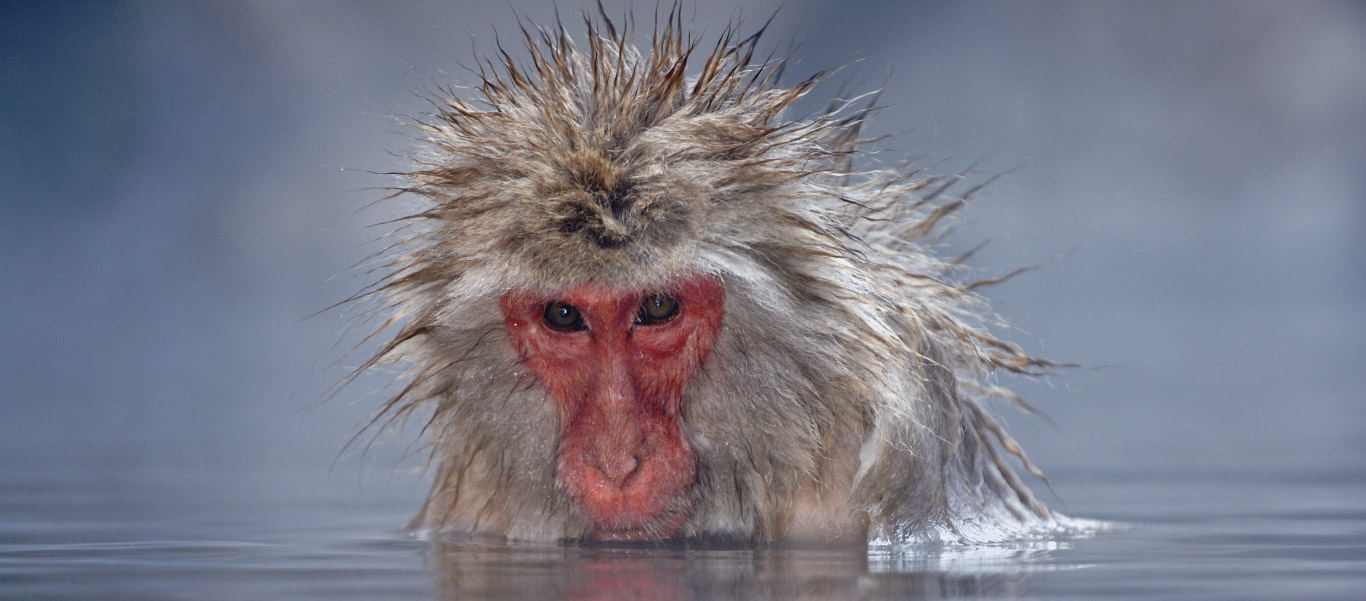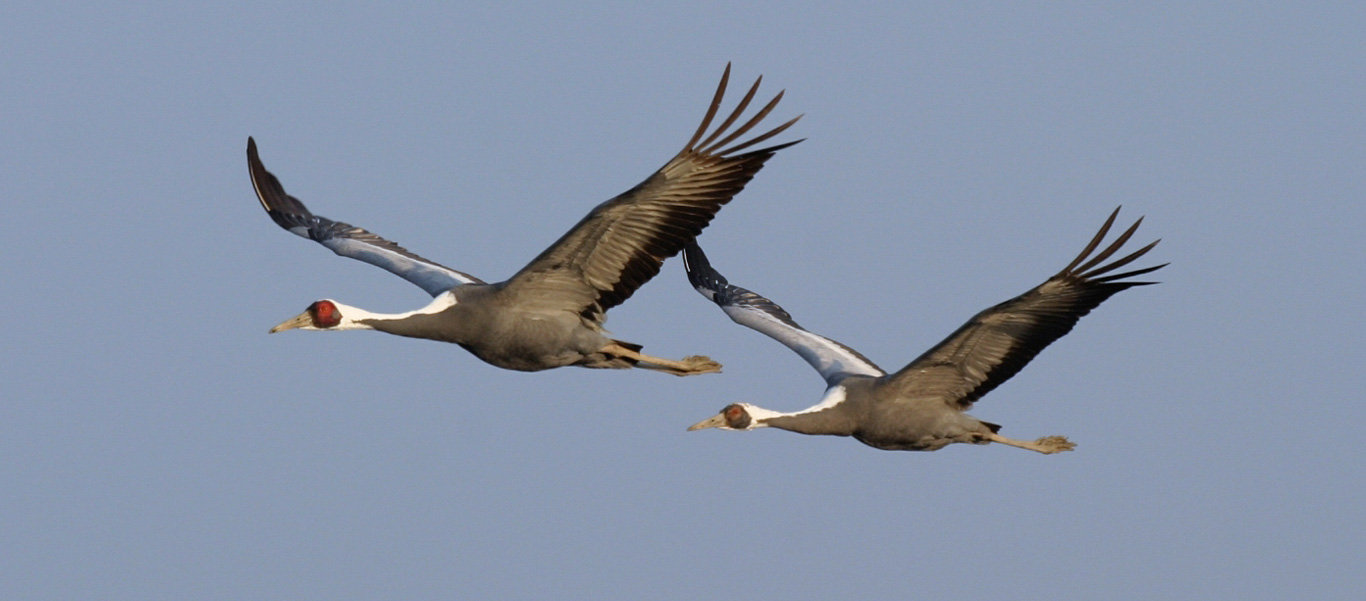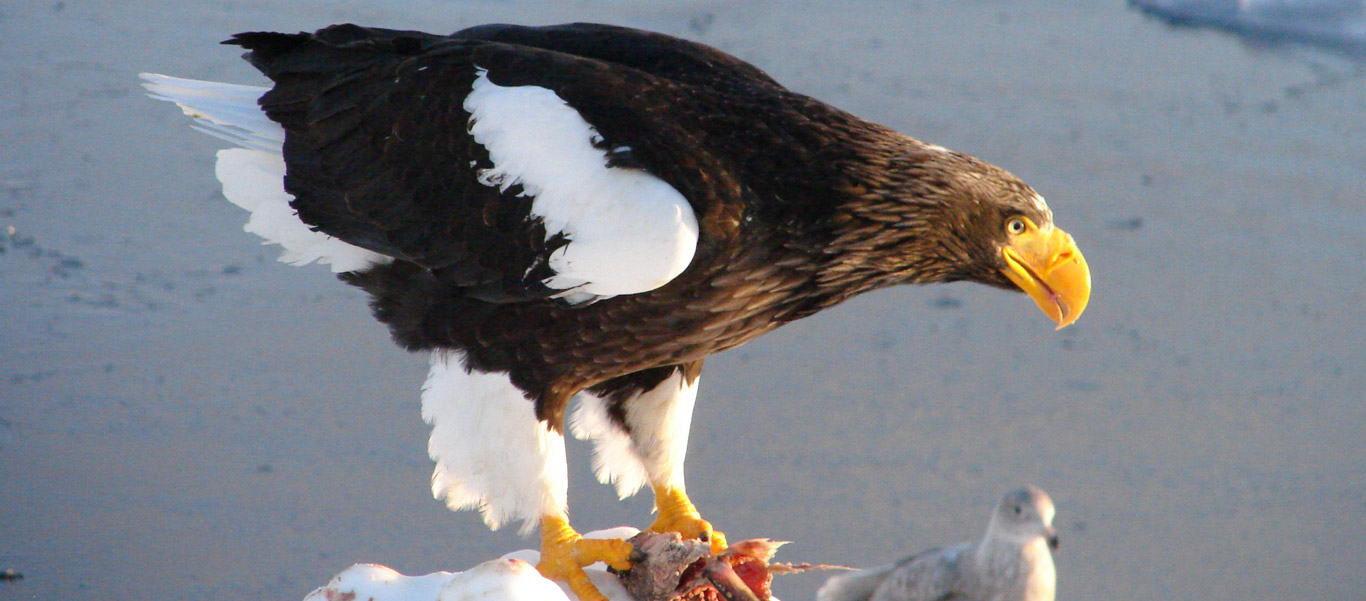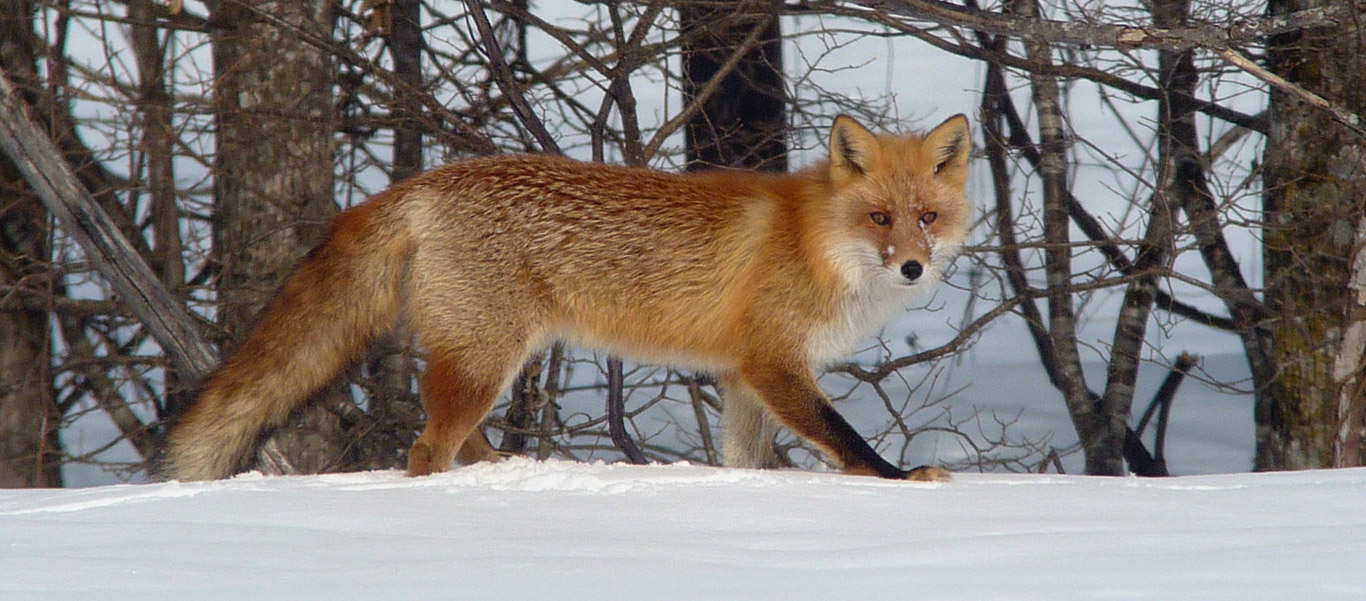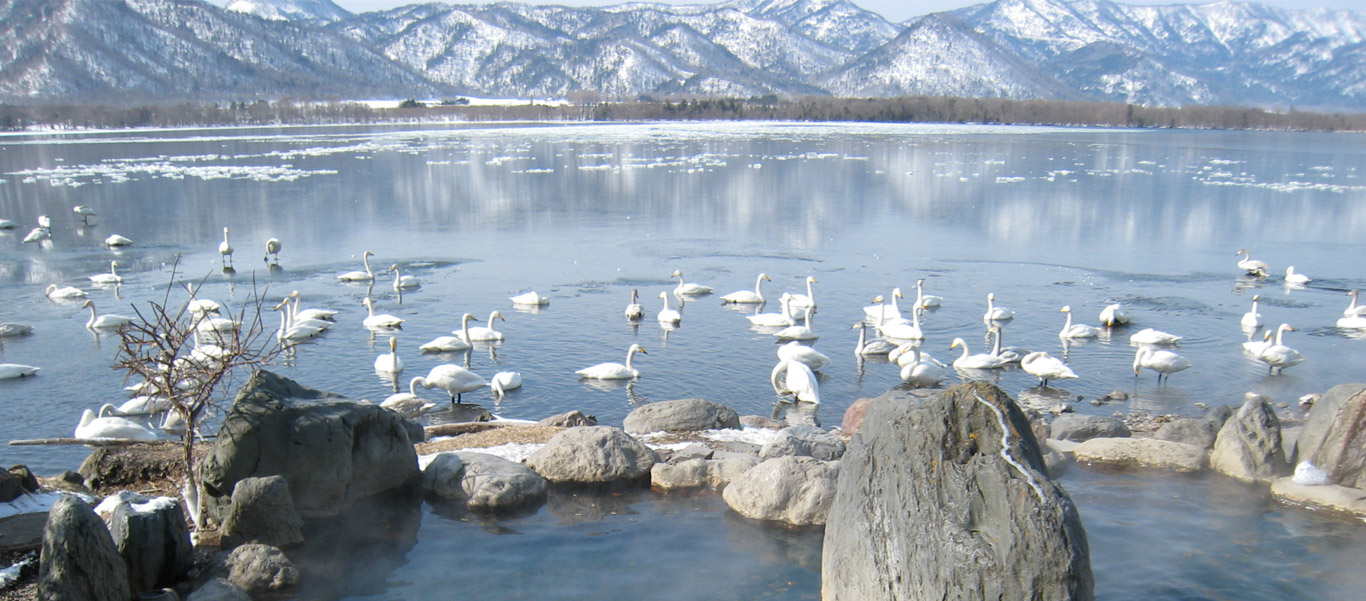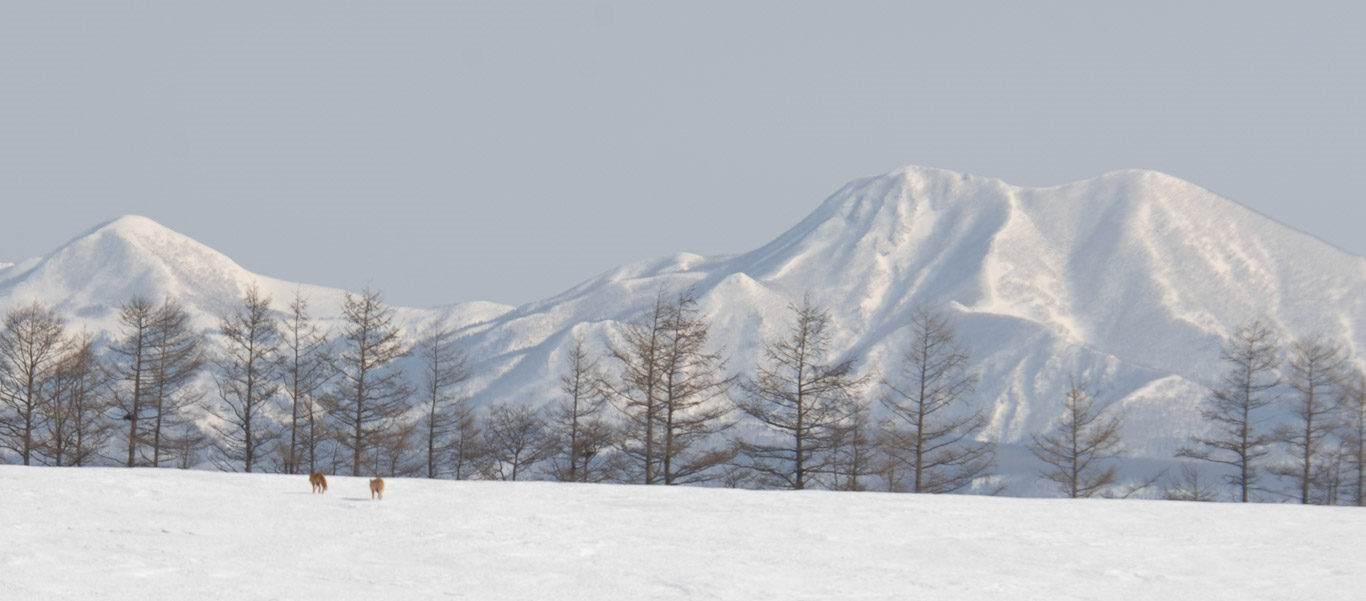Japan's Winter Wildlife
Japan Wildlife Tour
Japan is a diverse assemblage of islands with a rich culture and a fascinating array of wildlife that draws visitors year round. But unbeknownst to the average traveler, there is a wonderland of rugged landscapes and fascinating congregations of wildlife that only occur in the snowy winter months. Japan in winter excels with remarkable concentrations of Steller’s Sea Eagles on the ice edge at Shiretoko Peninsula and huge flocks of cranes on Kyushu Island, considered to be among the planet’s greatest wildlife spectacles. Our expedition also includes the enthralling Japanese Macaques and ends with the lavish ice carvings of the Sapporo Snow Festival. For travelers, photographers and wildlife enthusiasts, let us show you this unexpected side of Japan, delving deeper into the rich diversity of its ancient culture, exotic cuisine, and, above all else, its extraordinary wildlife.
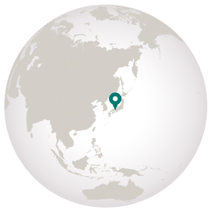
Destinations
- Travel by Air
- Travel by Road
- Travel by Boat
- Travel by Bullet Train
- Travel by Rail
- Travel by Dog Sled
- Day 1
- Day 2
- Days 3 & 4
- Day 5
- Day 6
- Days 7 & 8
- Day 9
- Days 10 & 11
- Day 12
- Day 13
- Day 14
- Day 15
- Day 16
- Day 17
-
Tokyo
Arrive at Tokyo’s Haneda Airport and transfer to our hotel for check in. Gather this evening with fellow travelers and expedition leaders Mark and Mayumi Brazil and Chieko Sakihana for a welcome dinner and briefing. Overnight at Haneda Excel Hotel.
-
Jigokudani
After breakfast, depart for a scenic drive through Japan’s immense capital, Tokyo, on our way toward the ruggedly mountainous Chūbu region of Honshu Island. Along the way, visit Lake Suwa to see some of Japan’s many wintering waterfowl, before continuing to Matsumoto. There, visit 400-year-old Matsumoto Castle. Also known as “Crow Castle,” because of its black exterior, it is one of Japan’s premier historical landmarks and is listed among the National Treasures of Japan. Arrive in Jigokudani in time to check into the serene Kanbayashi Hotel Senjukaku, your home base for the next three nights. Experience your first “haute” Kaiseki meal, then do as generations of Japanese people (and the local snow monkeys) do by taking a relaxing soak in Kanbayashi’s therapeutic onsen, or natural thermal spring. Overnight at Kanbayashi Hotel Senjukaku.
-
Jigokudani
Located in the Yokoyu River Valley, nearly 3,000 feet above sea level, this area was given the name Jigokudani, or Hell Valley, because of the volcanic vents that send clouds of steam into the air here. Frequently blanketed with snow during winter, the mountains enclosing Jigokudani are nevertheless home to a troop of Japanese Macaques, or “Snow Monkeys,” that visit the valley each day. They gather for food, to soak in their very own thermal pool, and to groom each other, as the steam rises around them. With or without snow, this is one of the many photographic highlights of our expedition.
The next two days will be spent observing and photographing the Japanese Macaques, the world’s most northern-living primate other than humans. Walk the mile-long trail from our hotel to Yaen-koen, where you can spend whole days watching the macaques as they forage on nearby slopes, play, squabble, and chase each other. Up to a hundred or more macaques have been known to visit Yaen-koen each day. Seeing so many at once is a wonderfully thrilling experience. We will also search for the shy and elusive Japanese Serow, another species endemic to Japan and the Asiatic equivalent of the New World’s Mountain Goat. Although birds are few in the valley, we may encounter Brown Dipper, or perhaps an Alpine Accentor. Enjoy a relaxing dip in the hot springs before dinners and overnights at Kanbayashi Hotel Senjukaku.
-
Magome
After breakfast, depart Jigokudani and drive along the Chuo Expressway before turning along the delightful Kiso River valley. Visit historical towns on the old Nakasendo Trail, the ancient route that connected Kyoto and Tokyo during the feudal period. Spend the afternoon photographing these historical towns and stay overnight in Tsutaya Kinosato Kazari, an inn near Magome.
-
Magome / Nagoya / Izumi
After breakfast, continue to Magome, also on the historical Nakasendo Trail. Feel transported as you pass landmarks that have changed little since the Edo period, some 300 years ago. Drive into the heart of Nagoya by bus for lunch, then board the famed bullet train, the Shinkansen, bound for Izumi in southwest Kyushu, the third largest island of Japan. Arrive in Izumi in the early evening. Dinner and overnight at Akune Grand View Hotel.
-
Izumi / Arasaki
Before breakfast, we set out to witness a birding spectacle without equal—the clamoring horde of cranes at Arasaki. Here, one of the largest gatherings of cranes in all of Asia spends the winter. Some 13,000-14,000 birds will be present with the majority consisting of 10,000 or more Hooded Cranes, with perhaps 2,000-3,000 elegant and graceful White-naped Cranes. We may even find small numbers of Common and Sandhill Cranes here too. In this season, there is constant and frenetic activity, almost bedlam, as families and groups arrive and depart for urgent foraging. If we are fortunate to observe their greeting and courtship rituals, we will see them bowing and sky-pointing while trumpeting loudly. Spend the next two days watching and photographing these beguiling birds, as well as the other birdlife in the Arasaki area.
With its bewildering diversity of habitats, including woodlands, scrub, and a mosaic of rice paddies, reed beds, drainage canals and streams, Arasaki sustains many species of avifauna. Scour these coastal reclaimed lands of western Kagoshima Prefecture for Common Shelduck, Northern Lapwing, Daurian Redstart, and Chestnut-eared and Common Reed Buntings. At the end of each day, we are sure to be in place to see the cranes returning to their roost. Dinner and overnight at Akune Grand View Hotel.
-
Izumi / Kagoshima / Tokyo / Kushiro
After breakfast, drive southeast to Kagoshima Airport for our flights that take us first to Tokyo then on to Kushiro, in the eastern part of Hokkaido, Japan’s northernmost island. In the nearby village of Tsurui, enjoy dinner and overnight at the welcoming, family-run hot spring Hotel Taito.
-
Kushiro Region
The next two days will be devoted to Red-crowned Cranes, as this is the best area, and the best season in this area, to view them. Kushiro Wetlands National Park and its environs harbor several roosting and feeding sites. By this time of year, the cranes have begun their spectacular courtship ritual: with a mix of icy mist and hot springs steam rising in the background, the birds bow, bob, pirhouette, leap and sky-point while giving their stirring duet. This behavior is often infectious, and it is possible to see dozens of cranes joining in the joy of the dance. Afternoon feeding sessions often draw White-tailed Eagles, Whooper Swans, and even Red Fox to the mix. While here, search the riverine woodlands for your first glimpse of the magnificent Steller’s Sea Eagle, and perhaps even a roosting Ural Owl. Time permitting, a visit to the Kushiro City Museum is well worthwhile, with its natural history exhibits and a display of artifacts relating to Hokkaido’s indigenous people, the Utari (widely known as Ainu). Dinners and overnights at Hotel Taito.
-
Rausu / Shiretoko Peninsula
This morning, head for Hokkaido’s east coast and eventually the Shiretoko Peninsula. Here, the largest accessible gathering of Steller’s Sea Eagles takes place every winter. One of the world’s largest and most powerful eagles—it is one and a half times the size of the Bald Eagle—up to 1,000 individuals are sometimes present along the peninsula. Weather and sea-ice permitting, visit the edge of the sea ice by boat and lure these kings of raptors with fish scraps. This is a rare photographic opportunity, as the eagles swoop down to nab the fish against a backdrop of sea ice and snow-clad peaks. On land, explore the peninsula, looking for concentrations of sea ducks offshore and individual Steller’s and White-tailed Eagles perching in trees above us on the coastal slopes. Dinner and overnight at Rausukuru.
-
Yoroushi / Akan Volcano National Park
If the sea-ice is close, rise before dawn for another chance to photograph sea eagles. After breakfast, drive along the Shiretoko Peninsula seeking out yet more eagles, then drive westward towards Akan and the hot spring valley of Yoroushi. Stay at a traditional family Ryokan within the territory of a pair of Blakiston’s Fish Owls, one of the rarest owls in the world. Only about 80 pairs survive in Hokkaido and they do so with the help of the local people, who often put out fish for them each evening. Huge and powerful, Blakiston’s Fish Owl is a “mega,” a must-see for birders and non-birders alike. We spend part of the evening searching for these rare birds. Dinner and overnight at Yuyado Daiichi.
-
Yoroushi / Akan Volcano National Park
From our base in Yoroushi we visit nearby Akan Volcano National Park, where we view the fumaroles at Iwo-zan. Visit Mashu-ko, the spectacular crater lake famous for having the highest level of water clarity on earth, and take time to photograph vociferous Whooper Swans at Lake Kussharo. This evening, you will have a second chance to watch for Blakiston’s Fish Owl. Dinner and overnight at Yuyado Daiichi.
-
Sapporo
Enjoy a scenic, full-day drive across Hokkaido toward Sapporo. Along the way, visit Arte Piazza Bibai, a magnificent sculpture park in the mountains featuring white marble and dark bronze sculptures by Kan Yasuda. Upon arrival in Sapporo, drop your bags at the hotel and venture out to the site of the Sapporo Snow Festival. Watch as ice carvers put the finishing touches on their carvings in the Susukino area of Sapporo, then, after dinner in town, overnight at the Sapporo Grand Hotel.
-
Sapporo
Spend the day taking in the sights and sounds of the lavish and eccentric Sapporo Snow Festival, seeing the massive sculptures around Odori Park. Celebrate an incredible journey this evening with a farewell dinner and overnight at the Sapporo Grand Hotel.
-
Sapporo
Depart on your international flights back home.

